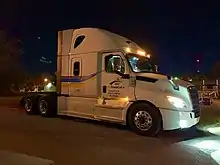Freightliner Cascadia
The Freightliner Cascadia is a heavy-duty semi-trailer truck and the flagship model of Freightliner. Its design took fuel efficiency into greater consideration, and several other features including the powertrain offerings, sound mitigation, safety systems, and overall mechanical reliability were improved from its predecessors. It is offered in three basic configurations: Day Cab, Mid-Roof XT, and Raised Roof. The latter two models are sleeper cabs, offered in various lengths ranging from 48 to 72 inches (Raised Roof models 60” or 72” lengths only). The Cascadia is sold chiefly in North America. Its place remains occupied by the Freightliner Century (no longer in US production) for export markets.
| Freightliner Cascadia | |
|---|---|
_Truck_Freightliner_at_Flying_J_Travel_Plaza_(2).jpg.webp) First-generation Freightliner Cascadia | |
| Overview | |
| Manufacturer | Daimler Trucks North America |
| Production | 2007-Present |
| Model years | 2008-Present |
| Assembly | Cleveland, North Carolina, United States |
| Body and chassis | |
| Class | Heavy truck |
| Body style | Conventional |
| Powertrain | |
| Engine | Detroit DD13/15/16, Cummins ISX15 EPA |
| Transmission | Detroit DT12 (Automated Manual) Eaton Fuller 8, 9, 10, 13, 15 and 18 speed (Manual) Eaton AutoShift 10, 13 or 18 speeds (Automated Manual) Eaton UltraShift Plus 10, 13, 18 Speeds (Automated Manual) Allison® 3000, 4000 and 4500 series (Automatic) |
| Chronology | |
| Predecessor | Freightliner Columbia, Freightliner Century |
Cascadia Evolution
The Cascadia Evolution is a more fuel-efficient version of the Cascadia, released in 2013 and equipped with the latest aerodynamic improvements of the time, as well as enhanced driver comfort and convenience features, such as a redesigned and easier to read instrument cluster, brand new seats with better back and lumbar support, ergonomically repositioned dashboard switches with larger, higher contrast text, and an available battery-powered auxiliary HVAC system from Thermo King, designed to reduce overnight engine idling, both saving fuel and reducing noise while drivers are asleep.
2017 refresh

In 2017, the Cascadia received a major design revision for the 2018 model year. The general design of the body is the same except for revised chassis fairings and longer cab extenders. The 2018 Cascadia's hood cowl has a more sculpted design, and also carries the new, more aggressively styled, all-LED headlights and a larger, bolder grille, as well as more aerodynamic hood mirrors. The front bumper is redesigned to match the new hood, and better bumper air dams were installed.[1]
Interior wise, the truck received a complete overhaul. An all-new dashboard and new, even more, ergonomic seats both make the truck very driver-centric and provide superior visibility. The Cascadia's sleeper contains a larger bunk, redesigned storage cabinets, new, aircraft-inspired dimmable LED ceiling lights; standard in raised roof sleepers; and the available "Driver's Loft" feature, which adds a collapsible table and two collapsible seats, all of which stow neatly underneath an extra-wide Murphy-style bunk. If equipped with an upper bunk, the raised roof sleeper also includes a standard telescopic ladder for easier access to the top bunk.
Battery-powered HVAC systems remain an option, however, in addition to the Thermo King units seen on the Cascadia Evolution, Freightliner now offers an internally manufactured equivalent system as well.
Other features of the truck include the Detroit DT12 automated manual transmission, ultra-quiet door and window seals, a single panel windshield, all LED marker lights and taillights, and a suite of active and passive safety systems, including blind-spot monitoring, collision mitigation system, lane-keeping assistance, and more.
The second-generation Cascadia is available in the same three configurations as its predecessors, Day Cab, Mid-roof XT, and Raised Roof.
eCascadia
The e-Cascadia is an all-electric truck variant of the Cascadia, scheduled for mass production release in 2021, with 250 mi (400 km) of Class-8 range, using 550 kWh batteries, and 730 hp (540 kW) peak horse power, with charging to 80% in 90 minutes (200 mi (320 km)). It has a load capacity GCWR of 80,000 lb (36,000 kg), and will compete with Tesla's own offering, the Semi.[2]
In August 2019, the first two eCascadias were delivered to customers in California as part of field tests. The manufacturer stated these trucks are built "to test the integration of battery-electric trucks [into] large-scale fleet operations".[3] One of the customers, Penske, will be operating the truck "in regional traffic in Southern California" while the other, NFI, will use it in drayage operations at the Port of Los Angeles and the Port of Long Beach.[4][5]
See also
- Freightliner Business Class M2, the eM2, another all-electric variant available from Freightliner
- Tesla Semi, another all-electric class-8 semi-tractor
References
- "Latest Freightliner Cascadia gets SuperTruck-Like Improvements". hankstruckforum.com. Retrieved 2 February 2018.
- James Menzies (6 June 2018). "Freightliner debuts electric Cascadia, M2". Truck News.
- https://daimler-trucksnorthamerica.com/company/newsroom/PressDetail/first-freightliner-ecascadia-battery-electric-trucks-2019-08-12
- https://media.daimler.com/marsMediaSite/en/instance/ko/Daimler-delivers-its-first-electric-Freightliner-eCascadia-to-US-customers.xhtml?oid=44194111
- https://www.greencarcongress.com/2019/08/20190823-ecascadia.html
- http://www.daimler-trucksnorthamerica.com/news/press-release-detail.aspx#detroit-dt12-automated-manual-transmission-now-2013-09-18, Giroux, David, "Detroit DT12 Automated Manual Transmission Now Available for Detroit DD13 Engine", 09/18/2013
External links
- Freightliner, 2017 Cascadia
- Freightliner, Cascadia Evolution
- Detroit DT12
